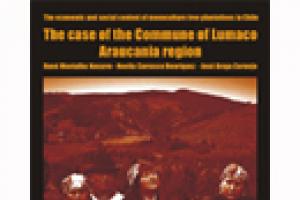The coastal village of Mehuin is located in the Northeastern zone of the Province of Valdivia, on the borders of the ninth and tenth regions of Chile. It is a small bay, fed by the river Lingue, and surrounded by the mountains of the coastal cordillera. It has a population of approximately 1,700 people, but co-inhabits with 13 communities comprising some 3,000 Mapuche-Lafkenche indigenous peoples who come down to the village to sell their products and to get supplies. Some very well defined sectors also exist in Mehuin, with their own cultural characteristics.
Chile
Other information
1 August 2006
Other information
1 August 2006
The Ñielol hill located near the city of Temuco in Chile’s Ninth Region, is a faithful witness to the numerous lies circulating both in this region and in many others in the country as well as in other countries, regarding forests and plantations.
Bulletin articles
6 May 2006
The commune of Lumaco, with its 11.405 inhabitants, is located in the Ninth Region of Chile. From the standpoint of the ancient Mapuche territoriality and the present Mapuche claim to territorial identities in this Region, Lumaco corresponds to the political centre of the Mapuche-Nalche (also known as “nagche” and “nag-che”) territory.
Other information
7 March 2006
Black-necked swans used to have their habitat in the Carlos Andwandter Nature Sanctuary on the Cruces River, a Ramsar site located in the northern zone of the city of Valdivia in the Tenth Region. The black-necked swan (Cygnus melancoryphus) is a migratory bird native of South America. Its landscapes are the wetlands of the south of Brazil, Uruguay, nearly all Argentina and Chile from the Fourth to the Tenth Region. It feeds on plants and in the Cruces River on a waterweed, the luchecillo (Egeria densa).
Other information
7 March 2006
Black-necked swans used to have their habitat in the Carlos Andwandter Nature Sanctuary on the Cruces River, a Ramsar site located in the northern zone of the city of Valdivia in the Tenth Region. The black-necked swan (Cygnus melancoryphus) is a migratory bird native of South America. Its landscapes are the wetlands of the south of Brazil, Uruguay, nearly all Argentina and Chile from the Fourth to the Tenth Region. It feeds on plants and in the Cruces River on a waterweed, the luchecillo (Egeria densa).
Bulletin articles
8 February 2006
Argentina-Chile: Young Mapuche opposed to the advance of plantation companies seeks political asylum
On 6 December, 23-year-old Pascual Pichun Collanao, a member of the Antonio Nirripil community from the Temulemu sector in the southern Chilean commune of Traiguen, formally requested political asylum in Argentina. The young man had been on the run since November 2003 when, with his brother Rafael they decided not to give themselves up to justice after being refused the right to freedom under surveillance because they were unable to pay a court fine. The brothers had been given a 5-year jail sentence for setting fire to a truck belonging to Forestal Minico in March 2002.
Other information
9 December 2005
Lumaco (which means “Moon water”) is a community of passage located in a large area of tree plantations and impoverished communities. Very little about it invites you to stay. Lumaco is part of the communes known in Chile as forestry communes.
Bulletin articles
12 October 2005
Celulosas Arauco and Constitución pulp mill, better known as Celco, located in Valdivia, belong to the Chilean Angelini group. It recently re-launched their operations after having been closed for 64 days following the scandal arising from the mass death of black-necked swans in the Rio Cruces sanctuary where it discharged its effluents.
Publications
18 August 2005
By René Montalba Navarro, Noelia Carrasco Henríquez and José Araya Cornejo
By means of testimonials, documents and figures, the present report sets out the problems faced by that commune of 11,405 inhabitants, where monoculture tree plantations have expanded violently, imposed by a forestry development model instituted during the military dictatorship and still currently in force.
Bulletin articles
14 August 2005
Annexation of Mapuche territory by the Chilean State and the imposition of its legal system on all the indigenous peoples that co-exist in the country have marked deep changes in the way of life of the Mapuche people. Between 1881 and 1907, stripped of their territory, their autonomy and their assets generated as an agricultural and cattle-raising society, the Mapuche people fell prey to hunger and to disease that took around twenty thousand victims.
Bulletin articles
20 May 2005
On 10 May, Zenen Diaz Necul, a 17 year-old Mapuche boy was run down by a truck when participating in a demonstration in repudiation of an attack carried out by the Mininco company’s forest guards against Mapuche symbolism and cultural, spiritual and religious elements. The protest took place in the area of the Malleco Viaduct (a historical railway bridge in southern Chile’s 9th Region).
This event has led the Arauco Malleco Mapuche Coordinating Committee to declare:
In view of the brutal murder of Diaz Necul, a young Mapuche boy:
Bulletin articles
26 December 2004
The Nature Sanctuary Carlos Anwandter at Rio Cruces is the Site that Chile incorporated as Wetland of International Importance when it adhered to the Ramsar Convention on Wetlands of International Importance especially as Waterfowl Habitat, in 1981. It is home to a wide diversity of species of flora and fauna, particularly black-necked swans (Cygnus melancoryphus), an endangered migratory bird. The Sanctuary and its swans are part of the identity and image of the inhabitants of the nearby city of Valdivia, closely linked to the riparian landscape.

